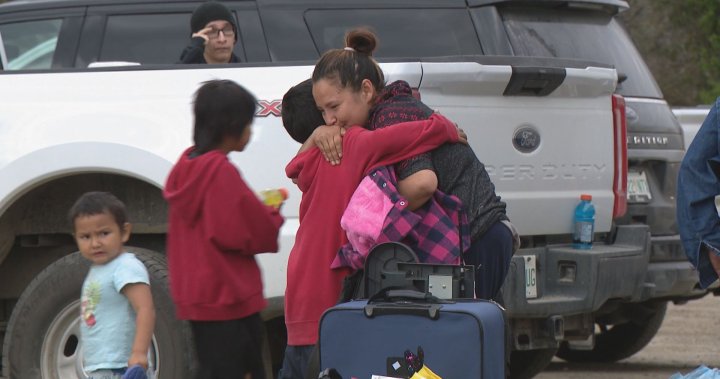The warm August sun brings welcome relief to residents of Île-à-la-Crosse, who have begun returning to their northern Saskatchewan community after spending weeks displaced by threatening wildfires. The evacuation order, which forced nearly 1,800 people from their homes in early July, was finally lifted last Thursday.
“Coming back feels like we can breathe again,” says Marie Bouvier, a 65-year-old elder who spent 23 days with relatives in Prince Albert. “But there’s still this heaviness in the air, both from lingering smoke and what we’ve all been through.”
As I walk through the community situated on the shores of Lac Île-à-la-Crosse, 375 kilometers northwest of Saskatoon, signs of the crisis remain visible. Thick layers of ash coat picnic tables and playground equipment. Some homes bear minor smoke damage. But the town itself stands intact – something many feared wouldn’t be the case.
Saskatchewan Public Safety Agency officials confirm the wildfire that threatened the community has been contained but remains active approximately 8 kilometers from town. Crews continue working to establish control lines, with 240 firefighters still deployed across the region’s active fire zones.
Mayor Duane Favel describes the evacuation as “the most challenging crisis our community has faced in generations.” Speaking from the local emergency operations center, he acknowledges the difficult road ahead. “We’ve got power restored, water systems checked, and basic services running again. But there’s significant cleanup work, and many residents are dealing with financial hardships from being away so long.”
The economic impact has been substantial. Local businesses closed for weeks, while many residents faced steep unexpected costs despite provincial evacuation support. The Saskatchewan Public Safety Agency reports providing accommodation assistance to over 4,200 evacuees from multiple northern communities, with hotel costs alone exceeding $3.6 million.
For 38-year-old commercial fisherman James McCallum, the evacuation’s timing couldn’t have been worse. “July and August are our peak months. I’ve lost about $15,000 in income I can’t get back,” he explains while cleaning ash from his boat. “The assistance helped with basic needs, but it doesn’t cover lost earnings.”
The community’s return coincides with concerning wildfire statistics. Saskatchewan’s wildfire management branch reports 452 wildfires this season – nearly double the five-year average. More than 1.8 million hectares have burned across the province, an area approximately three times the size of Prince Edward Island.
Climate scientists from the University of Saskatchewan have linked this season’s extreme fire behavior to climate change effects that are particularly pronounced in northern regions. “What we’re witnessing isn’t just a bad year,” explains Dr. Lauren Thompson, a climate adaptation researcher who studies northern communities. “It’s part of a pattern of increasing wildfire intensity that’s disproportionately affecting Indigenous and northern communities.”
The evacuation has been especially difficult for Île-à-la-Crosse’s significant Métis population, disrupting cultural practices and community bonds. The community, established in 1776 as a fur trading post, represents one of the oldest continuously inhabited Métis settlements in Canada.
Elder Gilbert McCallum, 78, spent the evacuation in Saskatoon worrying about culturally significant sites. “This land holds our stories, our ancestors. When you’re forced to leave, you worry what might be lost forever,” he tells me while examining smoke damage on his garden shed. “The berry patches, medicine gathering areas – they’ll take years to recover.”
Provincial officials estimate total firefighting costs will exceed $130 million this season, nearly triple the annual average. Saskatchewan Public Safety Minister Paul Merriman has promised additional recovery support for affected communities, though specific funding details remain under development.
For residents like Catherine Daigneault, a mother of three who evacuated to La Ronge, the return home brings mixed emotions. “My kids are excited to sleep in their own beds again, but they’re also scared,” she says, pointing to a nearby hillside where charred trees stand as stark reminders of how close the flames came. “My seven-year-old keeps asking if we’ll have to leave again.”
Community leaders are coordinating with mental health providers to offer support services for returning residents. The Northern Inter-Tribal Health Authority has established a temporary counseling center at the community school, with particular focus on helping children process the experience.
“Disasters like this leave invisible scars,” explains Rita Bouvier, a local health worker. “People experienced genuine trauma – the rush to evacuate, uncertainty about their homes, financial stress, and disruption of daily life. We need to acknowledge that healing takes time.”
As cleanup continues, the community is also looking ahead to long-term resilience planning. Mayor Favel indicates the town council will evaluate infrastructure improvements including dedicated water reservoirs for firefighting and enhanced communications systems that can withstand emergency conditions.
The Saskatchewan government faces growing pressure to reassess its wildfire management strategies. Opposition critics have called for expanded fire guard programs around vulnerable communities and increased investments in firefighting resources for northern regions.
With weeks still remaining in this year’s fire season, emergency officials urge returning residents to remain vigilant. The Saskatchewan Public Safety Agency maintains evacuation alerts for three other northern communities where nearby fires continue burning.
As the sun sets over Lac Île-à-la-Crosse, residents gather at the community dock, where a small welcome-home ceremony offers space for shared reflection. “We’re resilient people,” says elder Marie Bouvier. “This isn’t the first challenge we’ve faced, and it won’t be the last. But we face it together, as we always have.”






